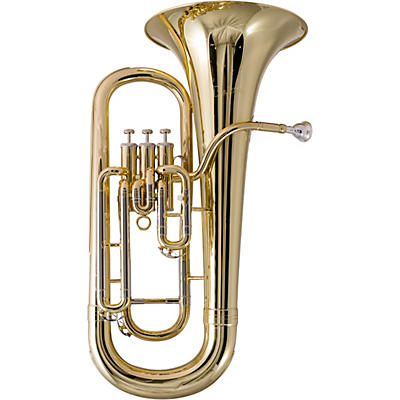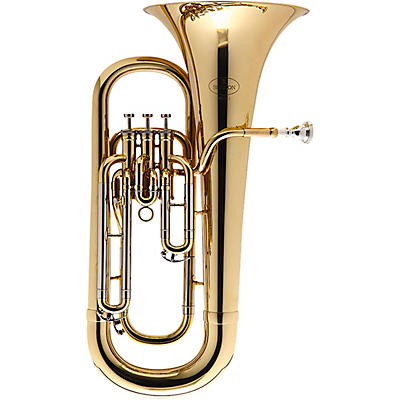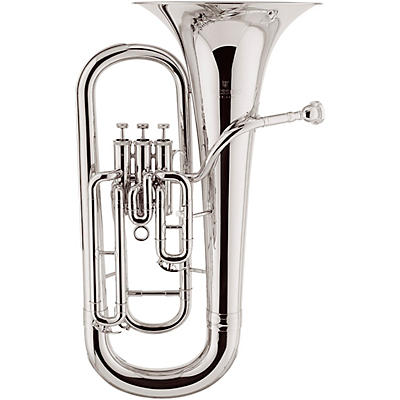Filters
Student Euphoniums
(6 Items)
10% Off $99+ w/ SPRING
SkuInfo [skuId=site1skuJ47425000000000, productId=site1prodJ47425, linkUrl=/brass-instruments/giardinelli-gep-300-series-3-valve-euphonium, imageId=GEP-300-Series-3-Valve-Euphonium/J47425000000000, displayName=Giardinelli GEP-300 Series 3-Valve Euphonium, description=null, brandName=Giardinelli, totalReviews=null, overallRating=null, priceVisibility=1, graphicalSticker=10% Off $99+ w/ SPRING, allUsed=false, onsale=false, lowPrice=1799.99, highPrice=1799.99, startingRestockPrice=null, restockItemCount=0, startingUsedPrice=null, usedItemCount=0, restockLinkURL=null, maxSaving=null, maxSavingPercent=null, maxSavingMSRP=null, externalInfo={}, productSeoUrl=/brass-instruments/giardinelli-gep-300-series-3-valve-euphonium, productVisibilityMSRP =1, storeName=null, storeId=null]
Giardinelli GEP-300 Series 3-Valve Euphonium
Product Price
$1,799.99
SkuInfo [skuId=site1sku483589000998000, productId=site1prod483589, linkUrl=/brass-instruments/yamaha-yep-201-series-3-valve-euphonium, imageId=YEP-201-Series-3-Valve-Euphonium-Lacquer/483589000998000, displayName=Yamaha YEP-201 Series 3-Valve Euphonium, description=null, brandName=Yamaha, totalReviews=1, overallRating=8, priceVisibility=1, graphicalSticker=null, allUsed=false, onsale=false, lowPrice=2401.99, highPrice=2976.99, startingRestockPrice=null, restockItemCount=0, startingUsedPrice=null, usedItemCount=0, restockLinkURL=null, maxSaving=1010.01, maxSavingPercent=30, maxSavingMSRP=3412.0, externalInfo={}, productSeoUrl=/brass-instruments/yamaha-yep-201-series-3-valve-euphonium, productVisibilityMSRP =1, storeName=null, storeId=null]
Yamaha YEP-201 Series 3-Valve Euphonium
from
Product Price
$2,401.99
SkuInfo [skuId=site1skuM14078000002000, productId=site1prodM14078, linkUrl=/brass-instruments/jupiter-jep705-standard-series-3-valve-student-euphonium, imageId=JEP705-Standard-Series-3-Valve-Student-Euphonium-Lacquer/M14078000002000, displayName=Jupiter JEP705 Standard Series 3-Valve Student Euphonium, description=null, brandName=Jupiter, totalReviews=null, overallRating=null, priceVisibility=1, graphicalSticker=null, allUsed=false, onsale=false, lowPrice=2499.0, highPrice=2999.0, startingRestockPrice=null, restockItemCount=0, startingUsedPrice=null, usedItemCount=0, restockLinkURL=null, maxSaving=850.0, maxSavingPercent=25, maxSavingMSRP=3349.0, externalInfo={}, productSeoUrl=/brass-instruments/jupiter-jep705-standard-series-3-valve-student-euphonium, productVisibilityMSRP =1, storeName=null, storeId=null]
Jupiter JEP705 Standard Series 3-Valve Student Euphonium
from
Product Price
$2,499.00
10% Off $99+ w/ SPRING
SkuInfo [skuId=site1sku620235000420000, productId=site1prod620235, linkUrl=/brass-instruments/besson-be1062-performance-series-3-valve-euphonium, imageId=BE1062-Performance-Series-3-Valve-Euphonium-Lacquer/620235000420000, displayName=Besson BE1062 Performance Series 3-Valve Euphonium, description=null, brandName=Besson, totalReviews=null, overallRating=null, priceVisibility=1, graphicalSticker=10% Off $99+ w/ SPRING, allUsed=false, onsale=false, lowPrice=2828.0, highPrice=3030.0, startingRestockPrice=null, restockItemCount=0, startingUsedPrice=null, usedItemCount=0, restockLinkURL=null, maxSaving=1505.0, maxSavingPercent=35, maxSavingMSRP=4333.0, externalInfo={}, productSeoUrl=/brass-instruments/besson-be1062-performance-series-3-valve-euphonium, productVisibilityMSRP =1, storeName=null, storeId=null]
Besson BE1062 Performance Series 3-Valve Euphonium
from
Product Price
$2,828.00
10% Off $99+ w/ SPRING
SkuInfo [skuId=site1skuL74445000002000, productId=site1prodL74445, linkUrl=/brass-instruments/blessing-bep1288-3-valve-4-4-euphonium, imageId=BEP1288-Standard-Series-3-Valve-Euphonium-Silver-plated/L74445000002000, displayName=Blessing BEP1288 Standard Series 3-Valve Euphonium, description=null, brandName=Blessing, totalReviews=null, overallRating=null, priceVisibility=1, graphicalSticker=10% Off $99+ w/ SPRING, allUsed=false, onsale=false, lowPrice=2395.0, highPrice=2695.0, startingRestockPrice=null, restockItemCount=0, startingUsedPrice=null, usedItemCount=0, restockLinkURL=null, maxSaving=2240.0, maxSavingPercent=48, maxSavingMSRP=4635.0, externalInfo={}, productSeoUrl=/brass-instruments/blessing-bep1288-3-valve-4-4-euphonium, productVisibilityMSRP =3, storeName=null, storeId=null]
Blessing BEP1288 Standard Series 3-Valve Euphonium
from
Product Price
$2,395.00
SkuInfo [skuId=site1skuJ23830000001000, productId=site1prodJ23830, linkUrl=/brass-instruments/jupiter-jep710-series-bell-front-3-valve-euphonium, imageId=JEP710-Standard-Series-Euphonium-JEP710-Lacquer/J23830000001000, displayName=Jupiter JEP710 Standard Series Euphonium, description=null, brandName=Jupiter, totalReviews=null, overallRating=null, priceVisibility=1, graphicalSticker=null, allUsed=false, onsale=false, lowPrice=2499.0, highPrice=2499.0, startingRestockPrice=null, restockItemCount=0, startingUsedPrice=null, usedItemCount=0, restockLinkURL=null, maxSaving=850.0, maxSavingPercent=25, maxSavingMSRP=3349.0, externalInfo={}, productSeoUrl=/brass-instruments/jupiter-jep710-series-bell-front-3-valve-euphonium, productVisibilityMSRP =1, storeName=null, storeId=null]
Jupiter JEP710 Standard Series Euphonium
Product Price
$2,499.00
In Greek, "eu" means "good" and "phonos" describes something related to sound - so when you learn that the euphonium's name comes from the Greek word "euphonos", you'll have an idea what to expect from an instrument whose name literally means "good-sounding". The euphonium is a close relative of the baritone horn, with a voice that's similar but a bit darker and mellower by comparison. It's also a lower-key instrument, with only the tuba below it on the conical-bore scale. Traditionally a band instrument, the euphonium is played in a variety of ensembles from brass quintets to service bands, and if you're looking to join one of those, this selection of student euphoniums is the place to start.
A good introduction to the euphonium would be a three-valve model, like the Jupiter 468 Series 3-Valve Euphonium or the Amati AEP 231E Series 3-Valve Euphonium. These are simplest format of the instrument, allowing for a straighShow More
A good introduction to the euphonium would be a three-valve model, like the Jupiter 468 Series 3-Valve Euphonium or the Amati AEP 231E Series 3-Valve Euphonium. These are simplest format of the instrument, allowing for a straighShow More










































































































































